Articles
- Page Path
- HOME > Korean J Community Nutr > Volume 21(2); 2016 > Article
-
Research Article
- Dietary Habits and Perception Toward Food Additives according to the Frequency of Consumption of Convenience Food at Convenience Stores among University Students in Cheongju
-
Munkyong Pae

-
Korean Journal of Community Nutrition 2016;21(2):140-151.
DOI: https://doi.org/10.5720/kjcn.2016.21.2.140
Published online: April 30, 2016
Department of Food and Nutrition, Chungbuk National University, Cheongju, Korea.
- Corresponding author: Munkyong Pae. Department of Food and Nutrition, Chungbuk National University, 1 Chungdae-ro, Seowon-gu, Cheongju 28644, Korea. Tel: (043) 261-2745, Fax: (043) 267-2742, mpae@chungbuk.ac.kr
Copyright © 2016 The Korean Society of Community Nutrition
This is an Open-Access article distributed under the terms of the Creative Commons Attribution Non-Commercial License (http://creativecommons.org/licenses/by-nc/3.0/) which permits unrestricted non-commercial use, distribution, and reproduction in any medium, provided the original work is properly cited.
- 440 Views
- 10 Download
- 20 Crossref
Abstract
-
Objectives
- This study was performed to examine the consumption patterns of convenience food at convenience stores, dietary habits, and perception as well as knowledge of food additives among university students.
-
Methods
- Subjects were 352 university students in Cheongju, Korea, and data was collected by a self-administered questionnaire. They were divided into three groups according to the frequency of consumption of convenience food at convenience stores: 79 rare (≤ 1 time/month), 89 moderate (2-4 times/month) and 184 frequent (≥ 2 times/week).
-
Results
- More subjects from the frequent consumption group lived apart from parents (p<0.001) and possessed more pocket money (p<0.01). Frequent consumption group consumed noodles, Kimbab, and sandwich & burger significantly more often (p<0.001, respectively) than others. In addition, frequent consumption of convenience foods at convenience stores was associated with frequent breakfast skipping (p<0.05), irregular meal time (p<0.01), snacking (p<0.05), and eating late night meal (p<0.001). More from the rare consumption group had heard about food additives previously compared to the frequent consumption group (79.7% vs. 63.6%, p<0.01). Frequent consumption group showed significantly higher score than did the rare consumption group for the following questions: monosodium glutamate is harmful to your health (p<0.05), food additives are necessary for food manufacturing (p<0.005), food additives need to be labeled on products (p<0.05), there is no food additive at all if labeled as no preservatives, no coloring, and no added sugar (p<0.05). There was a significant difference in degrees of choosing products with less food additives depending on the consumption pattern.
-
Conclusions
- Our results provided a better understanding of the factors associated with frequent consumption of convenience foods at convenience stores among university students and will be useful to develop a nutrition education program for those who are more prone to consume convenience foods.
Acknowledgments
Acknowledgments
- 1. Im JB, Seo BS, Lee HG, Chang YK. Life style and dietary pattern. J Korean Home Econ Assoc 1990; 28(3): 33-52.
- 2. Lim YS, Park HR, Han GJ. Comparison of preference for convenience and dietary attitude in college students by sex in Seoul and Kyunggi-do area. J Korean Diet Assoc 2005; 11(1): 11-20.
- 3. Jung EY, Lim YH, Park MS, Kim MW. A survey of the consumption of convenience foods. Korean J Community Nutr 2002; 7(2): 149-155.
- 4. Choi NJ. A study of nutrient content and consumption pattern of fast foods. Korean Consumer Agency; 2003 03.
- 5. Kim K, Park E. Nutrient density of fast-food consumed by the middle school students in Cheongju city. Korean J Community Nutr 2005; 10(3): 271-280.
- 6. Ji HJ, Kim SK, Yon MY, Hyun TS. Folate content of fast foods and processed foods. Korean J Nutr 2009; 42(4): 397-405.Article
- 7. Lee YS. The effects of university students' perception and knowledge about food additives on dietary life in Seoul [master's thesis]. Konkuk University; 2010.
- 8. Kang HJ, Byun KW. Effect of two-year course of food and nutrition on improving nutrition knowledge, dietary attitudes and food habits of junior college female students. Korean J Community Nutr 2010; 15(6): 750-759.
- 9. Kim MH, Kim H, Lee WK, Kim SJ, Yeon JY. Food habits and dietary behavior related to using processed food among male college students residing in dormitory and self-boarding in Gangwon. Korean J Community Nutr 2013; 18(4): 372-385.Article
- 10. Lee SL, Lee SH. Survey on health-related factors, nutrition knowledge and food habits of college students in Wonju area. Korean J Community Nutr 2015; 20(2): 96-108.Article
- 11. Ko MS. The comparison in daily intake of nutrients, dietary habits and body composition of female college students by body mass index. Nutr Res Pract 2007; 1(2): 131-142.ArticlePubMedPMC
- 12. Kim KH. A Study of the dietary habits, the nutritional knowledge and the consumption patterns of convenience foods of university students in the Gwangju area. Korean J Community Nutr 2003; 8(2): 181-191.
- 13. Lee KA, Cho EJ, Yoon HS. A study on consumption of convenience foods of university students by residing types in Changwon and Masan area. J Korean Diet Assoc 2010; 16(3): 279-290.
- 14. Kim HK, Kim JH, Jung HK. A comparison of health related habits, nutrition knowledge, dietary habits, and blood composition according to gender and weight status of college students in Ulsan. Korean J Nutr 2012; 45(4): 336-346.Article
- 15. Moon SJ, Yoon HJ, Kim JH, Lee YJ. A study on the perception and consumption pattern of convenience foods by Korean college students. Korean J Diet Cult 1998; 13(3): 227-239.
- 16. Han MH, Cho KB, Lyu ES. Study on consumption patterns and degree of checking food-nutrition labeling of convenience foods at convenience stores by young adult workers in Busan. J Korean Soc Food Sci Nutr 2014; 43(2): 309-317.Article
- 17. Kim SJ, Bu SY, Choi MK. Preference and the frequency of processed food intake according to the type of residence of college students in Korea. Korean J Community Nutr 2015; 20(3): 188-196.Article
- 18. You JS, Chin JH, Kim MJ, Chang KJ. College students' dietary behavior, health-related lifestyles and nutrient intake status by physical activity levels using International Physical Activity Questionnaire (IPAQ) in Incheon area. Korean J Nutr 2008; 41(8): 818-831.
- 19. Park EJ. Perception and consumption status of food labeling of processed foods among college students in Daegu? Gyeongbuk area. J East Asian Soc Diet Life 2013; 23(6): 671-680.
- 20. Kim EJ, Na HJ, Kim YN. Awareness on food additives and purchase of processed foods containing food additives in middle school students. J Korean Living Sci Assoc 2007; 16(1): 205-218.Article
- 21. Jung HY, Jung LH. Recognition of food additives of high school students in Gwangju. J Korean Home Econ Educ Assoc 2009; 21(4): 1-17.
- 22. Han MY, Ahn MS. A study on the purchase action of processed foods and the recognition for food additives of urban housewives. Korean J Diet Cult 1998; 13(2): 119-126.
- 23. Korean Society for the Study of Obesity. Guideline for treatment of obesity. Seoul: Korean Society for the Study of Obesity; 2012. p. 17-21.
- 24. Chang SO. The amount of sodium in the processed foods, the use of sodium information on the nutrition label and the acceptance of sodium reduced ramen in the female college students. Korean J Nutr 2006; 39(6): 585-591.
- 25. Kim JR. A report on quality examination of Triangular Kimbab at convenience stores. Korean Consumer Agency; 2013 07.
- 26. Ministry of Health and Welfare, Korea Centers for Disease Control and Prevention. Korea National Health and Nutrition Examination Survey (KNHANES-VII). 2015 12. Report No. 11702.
- 27. Chung EJ, Shim EG. Salt-related dietary behaviors and sodium intakes of university students in Gyeonggi-do. J Korean Soc Food Sci Nutr 2008; 37(5): 578-588.Article
- 28. Choi JG, Shin MK, Seo ES. A study on self-evaluated obesity and food habits by residence type of college students in Ik-San area. J Korean Living Sci Assoc 2004; 13(1): 97-110.
- 29. Choi MK, Jun YS, Park MK. A study on eating patterns and nutrient intakes of college students by residences of self-boarding and home with parents in Chungnam. J Korean Diet Assoc 2000; 6(1): 9-16.
- 30. Kim HC, Kim MR. Analysis on recognition, practice and information acquisition behaviors regarding food additives of university students. J East Asian Soc Diet Life 2014; 24(5): 572-584.Article
- 31. Jeon SI. Problems in the delivery of food additives information and government strategies for them. Ministry of Food and Drug Safety; 2006 11.
REFERENCES
General characteristics of the subjects by self-reported frequency of convenience food consumption at convenience stores
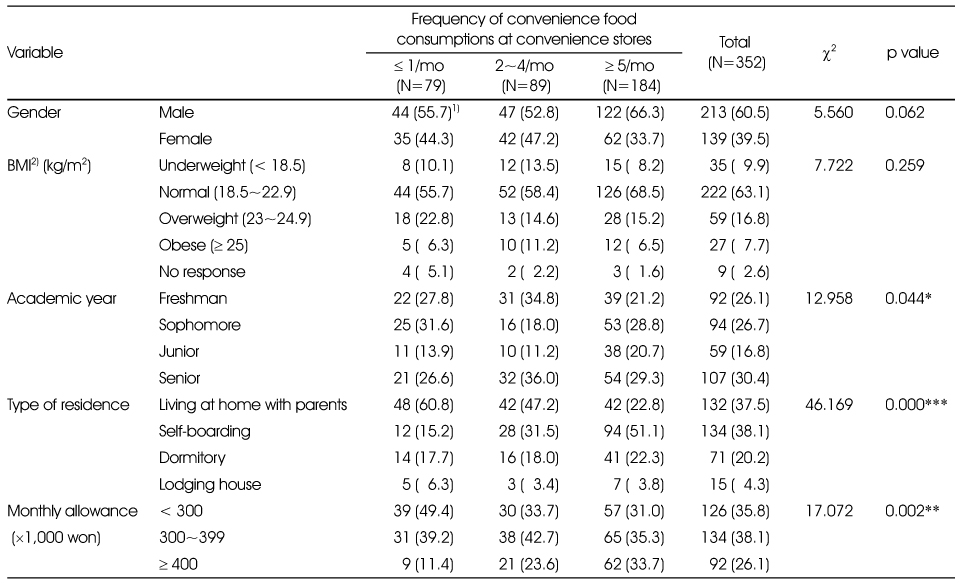
Consumption pattern of subjects by self-reported frequency of convenience food consumptions at convenience stores

Frequency score of convenience food consumptions at convenience stores1)

1) 7: daily, 6: 6 times per week, 4.5: 4~5 times per week, 2.5: 2~3 times per week, 1: once per week, 0.625: 2~3 times per month, 0: never (mostly not)
2) Mean±SD
abc: Values with different superscripts within each row are significantly different at p=0.05 by Duncan's multiple range test.
**: p<0.01, ***: p<0.001 by ANOVA
Dietary habits of the subjects by self-reported frequency of convenience food consumptions at convenience stores

Recognition of subjects regarding food additives by self-reported frequency of convenience food consumptions at convenience stores
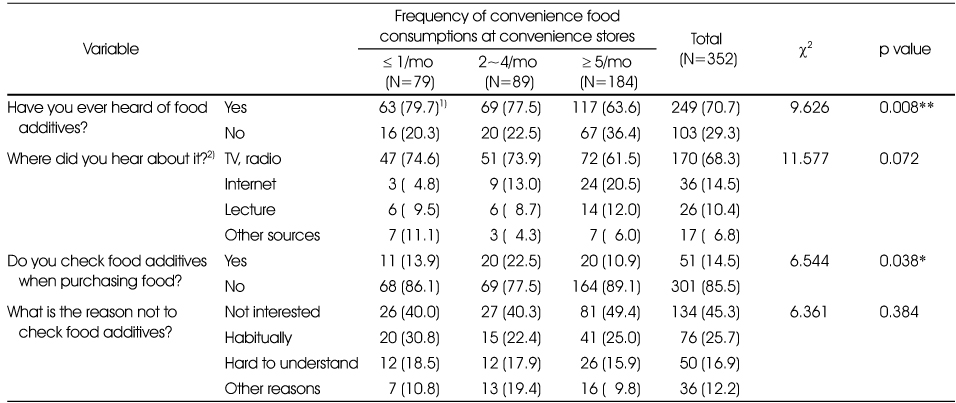
Perception of subjects regarding food additives by self-reported frequency of instant food consumptions at convenience stores
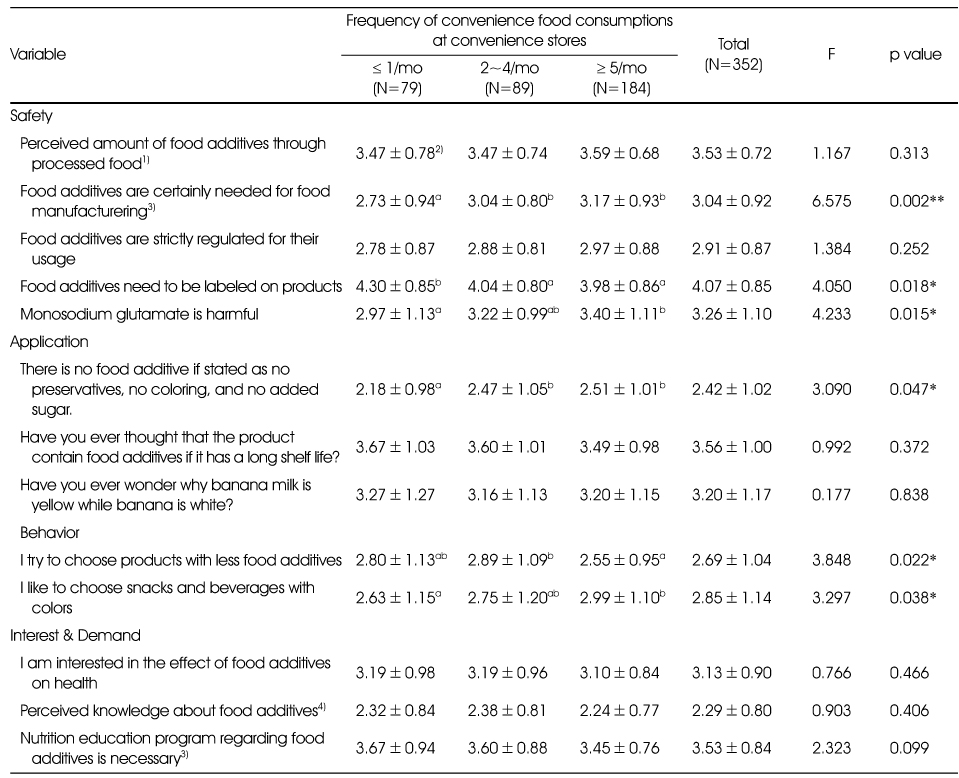
1) 5-point Likert scale was used from 1 (consume very little) to 5 (consume too much)
2) Mean±SD
3) 5-point Likert scale from 1 (strongly disagree) to 5 (strongly agree)
4) 5-point Likert scale from 1 (do not know at all) to 5 (know very well)
ab: Values with different superscripts within each row are significantly different at p=0.05 by Duncan's multiple range test.
*: p<0.05, **: p<0.01 by ANOVA
Figure & Data
REFERENCES
Citations

- A study on the consumer behavior and attitude toward low-sodium convenience store foods
Suah Moon, Jimin Lim, Gaeun Yeo, Yuri Kim, Jieun Oh
Nutrition Research and Practice.2024; 18(4): 567. CrossRef - Usage and Quality Satisfaction of Convenience Food at Convenience Stores according to the Eating Behavior of University Students in Southern Gyeonggi Province
Se-In Oh, Ok-Sun Kim
Journal of the East Asian Society of Dietary Life.2023; 33(6): 492. CrossRef - Choice Experiment Assessment of Consumer Preferences for Yogurt Products Attributes: Evidence from Taiwan
Min-Yen Chang, Chien-Cheng Huang, Ying-Chi Du, Han-Shen Chen
Nutrients.2022; 14(17): 3523. CrossRef - Energy and nutrition evaluation per single serving package for each type of home meal replacement rice
In-Young Choi, Jee-Young Yeon, Mi-Hyun Kim
Journal of Nutrition and Health.2022; 55(4): 476. CrossRef - Change of dietary habits and the use of home meal replacement and delivered foods due to COVID-19 among college students in Chungcheong province, Korea
Mi-Hyun Kim, Jee-Young Yeon
Journal of Nutrition and Health.2021; 54(4): 383. CrossRef - Analysis of Usage, Preference, and Satisfaction for Convenience
Store Dessert among University Students in Chungbuk Area
Go Eun Lee, Hye-In Yang, Yun-Jung Bae
Journal of Biotechnology and Bioindustry.2021; 9: 63. CrossRef - The Effect of Frequent Use of Convenience Food from Convenience Stores on the Diet Quality of Women’s University Students: Using the Nutrition Quotient for Korean Adults
Sun Hee Lee, Seung-Lim Lee
The Korean Journal of Community Living Science.2021; 32(4): 581. CrossRef - Knowledge, Perception, and Consumption of Food Additives among Female Lecturers in Zaria, Nigeria
Muhammed Sani Ibrahim, Aminu Lawal, Ahmed Ayuba Umar, Sunday Asuke
Nigerian Journal of Medicine.2021; 30(3): 232. CrossRef - Status of serving labeling of home meal replacement-soups and stews, and evaluation of their energy and nutrient content per serving
Mi-Hyun Kim, In-Young Choi, Jee-Young Yeon
Journal of Nutrition and Health.2021; 54(5): 560. CrossRef - Convenience Store Use and the Health of Urban Adolescents in Seoul, South Korea
Nan-He Yoon, Changwoo Shon
International Journal of Environmental Research and Public Health.2020; 17(18): 6486. CrossRef - Predictive Growth Modeling of Listeria monocytogenes in Rice Balls and Its Risk Assessment
Seoungsoon Yeo, Misook Kim
Journal of Food Quality.2020; 2020: 1. CrossRef - Evaluation of Dietary Quality and Nutritional Status according to the Use of Nutrition Labeling and Nutrition Claims among University Students in Chungbuk Area: Based on Nutrition Quotient
Yun-Jung Bae, Seo Young Park, Hye-Rin Bak
Korean Journal of Community Nutrition.2020; 25(3): 179. CrossRef - Nutritional Assessment Focusing on Minerals of Ready-to-Cook Foods Sold in Korea
Eun-Sun Park, Mi-Hyun Kim, Mi-Kyeong Choi
Journal of the East Asian Society of Dietary Life.2019; 29(6): 501. CrossRef - Association between frequency of convenience foods use at convenience stores and dietary quality among high school students in Incheon
Eun-Mi Kim, Mi-Kyeong Choi, Mi-Hyun Kim
Journal of Nutrition and Health.2019; 52(4): 383. CrossRef - Study on Middle and High School Students' Use of Convenience Foods at Convenience Stores in Incheon
Seul-Ki Lee, Mi-Kyeong Choi, Mi-Hyun Kim
Korean Journal of Community Nutrition.2019; 24(2): 137. CrossRef - Sleep Quality and Its Association with the Dietary Behavior and Lifestyle of University Students in Cheongju
Sewhan Jin, Munkyong Pae
Korean Journal of Community Nutrition.2019; 24(5): 395. CrossRef - Importance-Satisfaction Analysis of Selection Attributes and Consumer Demand for the Development of Healthy Premium Gimbap
Phil-Yeo Kwon, Wan-Soo Hong
Korean Journal of Food and Cookery Science.2018; 34(2): 201. CrossRef - Nutritional Evaluation of Convenience Meals in Convenience Stores near the Universities
Go-Na Shin, Yu-Ri Kim, Mi-Hyun Kim
Korean Journal of Community Nutrition.2017; 22(5): 375. CrossRef - Short-Term Effect of Convenience Meal Intake on Glycemic Response and Satiety among Healthy College Students in South Korea
Eunji Jang, Jeunghyun Lee, Sukyeong Lee, Mi-Hyun Kim
Clinical Nutrition Research.2017; 6(3): 215. CrossRef - Lunch Eating Patterns and Dietary Habits of University Students according to Major Lunch Place
Hyunji Kim, Hongmie Lee
Journal of the Korean Dietetic Association.2016; 22(4): 261. CrossRef
General characteristics of the subjects by self-reported frequency of convenience food consumption at convenience stores
1) N (%)
2) Body mass index
*: p<0.05, **: p<0.01, ***: p<0.001 by chi-square test
Consumption pattern of subjects by self-reported frequency of convenience food consumptions at convenience stores
1) Except for the subjects who never purchase instant foods from convenience stores
2) N (%)
Frequency score of convenience food consumptions at convenience stores1)
1) 7: daily, 6: 6 times per week, 4.5: 4~5 times per week, 2.5: 2~3 times per week, 1: once per week, 0.625: 2~3 times per month, 0: never (mostly not)
2) Mean±SD
abc: Values with different superscripts within each row are significantly different at p=0.05 by Duncan's multiple range test.
**: p<0.01, ***: p<0.001 by ANOVA
Dietary habits of the subjects by self-reported frequency of convenience food consumptions at convenience stores
1) N (%)
*: p<0.05, **: p<0.01, ***: p<0.001 by chi-square test
Recognition of subjects regarding food additives by self-reported frequency of convenience food consumptions at convenience stores
1) N (%)
2) Except for the subjects who never heard of food additives
*: p<0.05, **: p<0.01 by chi-square test
Perception of subjects regarding food additives by self-reported frequency of instant food consumptions at convenience stores
1) 5-point Likert scale was used from 1 (consume very little) to 5 (consume too much)
2) Mean±SD
3) 5-point Likert scale from 1 (strongly disagree) to 5 (strongly agree)
4) 5-point Likert scale from 1 (do not know at all) to 5 (know very well)
ab: Values with different superscripts within each row are significantly different at p=0.05 by Duncan's multiple range test.
*: p<0.05, **: p<0.01 by ANOVA
Knowledge of the subjects regarding food additives by self-reported frequency of instant food consumptions at convenience stores
1) Score 1 for correct answer, score 0 for wrong answer or I don't know, Mean±SD
Information needs of the subjects by self-reported frequency of convenience food consumptions at convenience stores
1) N (%)
1) N (%) 2) Body mass index *: p<0.05, **: p<0.01, ***: p<0.001 by chi-square test
1) Except for the subjects who never purchase instant foods from convenience stores 2) N (%)
1) 7: daily, 6: 6 times per week, 4.5: 4~5 times per week, 2.5: 2~3 times per week, 1: once per week, 0.625: 2~3 times per month, 0: never (mostly not) 2) Mean±SD abc: Values with different superscripts within each row are significantly different at p=0.05 by Duncan's multiple range test. **: p<0.01, ***: p<0.001 by ANOVA
1) N (%) *: p<0.05, **: p<0.01, ***: p<0.001 by chi-square test
1) N (%) 2) Except for the subjects who never heard of food additives *: p<0.05, **: p<0.01 by chi-square test
1) 5-point Likert scale was used from 1 (consume very little) to 5 (consume too much) 2) Mean±SD 3) 5-point Likert scale from 1 (strongly disagree) to 5 (strongly agree) 4) 5-point Likert scale from 1 (do not know at all) to 5 (know very well) ab: Values with different superscripts within each row are significantly different at p=0.05 by Duncan's multiple range test. *: p<0.05, **: p<0.01 by ANOVA
1) Score 1 for correct answer, score 0 for wrong answer or I don't know, Mean±SD
1) N (%)

 KSCN
KSCN
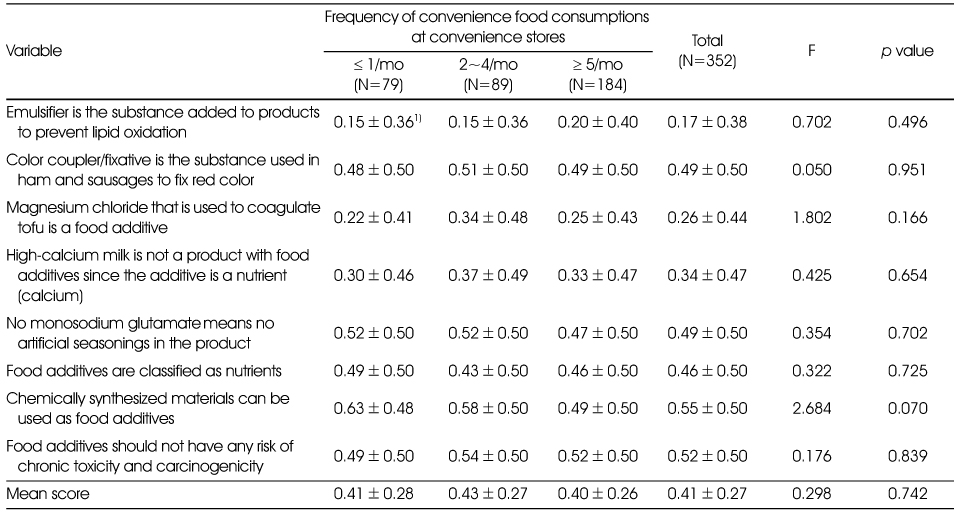
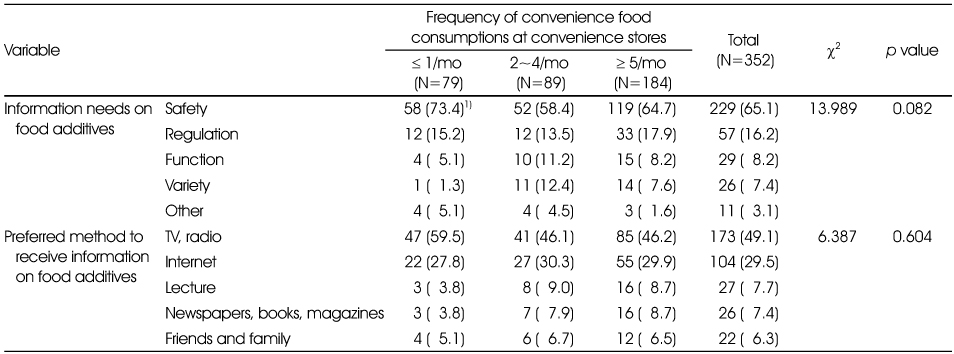
 PubReader
PubReader Cite
Cite


